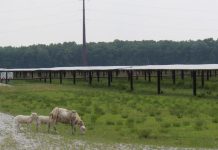For instance, the Wisconsin-based small engine manufacturer Briggs & Stratton recently announced 228 layoffs plus 120 more by its supplier Adecco USA, effective in August, citing the pandemic’s effect on its lawnmower and pressure washer business.
Some states are trying to boost manufacturing job numbers by helping factories reach out to potential customers of barriers, masks, and other personal protective equipment, or PPE. California helped create an online marketplace for that purpose in June, and similar markets were set up with state help in Missouri, Indiana and Ohio.
Those states are some of the most dependent on manufacturing jobs. California has the largest number of manufacturing jobs, while those in Indiana make up the largest share of total jobs, 20%, according to the Bureau of Labor Statistics.
States are easing the path in other ways, too. As manufacturers look to make protective equipment on the side, many are worried about liability, said Linda Kelly, general counsel for the National Association of Manufacturers, a trade group.
“You now have digital printing facilities making face shields, or textile makers that now make masks and gowns,†Kelly said. “If I’m making something I’ve never made before, am I going to be held to some obscure standard when I’m just trying to step up and do the right thing in an emergency?â€
At least eight states have passed laws or issued an executive order to limit liability during the pandemic, and three more are considering it.
Iowa, where 17% of jobs are in manufacturing, behind only Indiana and Wisconsin, enacted a law in June shielding manufacturers of coronavirus-related protective equipment from personal injury or death lawsuits unless they’re based on “recklessness or willful misconduct.â€
Indiana has had many factory layoffs in the automotive industry. Pittsburgh Glass Works in Evansville, a subsidiary of Vitro Automotive, brought its 360 workers back in May after an eight-week coronavirus hiatus, only to notify them the same week that the plant had to close permanently at the end of the year. Its parent company cited oversupply in the market.
Faced with such examples, Indiana in June began offering $4 million in “manufacturing readiness†grants to help factories modernize or start making emergency health care supplies related to the coronavirus.
Automotive manufacturers across the country, including makers of parts and supplies, are having the most trouble bouncing back.
Jobs in that sector dropped by 40% or about 580,000 jobs between March and April and increased by about 35,000 in May as some automakers started adding shifts again, according to a Stateline analysis of Current Population Survey data provided by the University of Minnesota.
The slight improvement in automotive jobs will be hard to sustain because there’s a worldwide glut of unsold cars, said William Spriggs, chief economist for the AFL-CIO and a former assistant labor secretary in the Obama administration.
“The drop in demand has been more precipitous than the Great Recession,†Spriggs said. “Unlike the Great Recession, the headwinds now are more like a hurricane.â€
Ford Motor Company has called for a federal “cash for clunkers†program, similar to one in California begun in 2009 to get old cars off the road and boost demand.
But that’s not going to help much if other countries start dumping unsold cars in the United States, seeking better returns from the strong U.S. dollar, Spriggs said. At the same time, bankrupt Hertz put its fleet on the used-car market.
States and cities will add to the glut when budget cutbacks force them to stop buying new cars for their own fleets, he added.
Automotive plants large and small have been turning to PPE as a side job.
Cadillac Parts, a parts supplier near Detroit, began making hospital gowns when managers heard local hospitals were in desperate need.
Auto plants in Indiana, Michigan, Mississippi, and Tennessee now manufacture face shields and ventilators.
Some types of factories have not been able to retool during the pandemic. Ohio’s Libbey Glass, which produces glassware for institutions and restaurants, sought Chapter 11 bankruptcy protection June 1 after halting production in Toledo and Shreveport, Louisiana.
Libbey’s troubles are a blow to Toledo, where the 200-year-old company has deep roots and founded an art museum and a zoo, earning the city the title of “City of Glass.â€
“This does a lot of damage to a city as far as taxes and business, the price of a home and just the feeling that life is good here,†said Clinton Longenecker, a business professor at the University of Toledo.
Still, it’s part of a long process that forces factories to constantly adapt to stay viable, Longenecker said.
“You can look back to the 90s when manufacturers were fleeing Ohio and Michigan for North Carolina, South Carolina, then overseas,†Longenecker said.
“The downturn is forcing people to get creative and innovative,†Longenecker said, referring to Designetics and its new line of protective barriers. “We’ll see a lot of positive things when the economy returns to normal if we can just survive this current crisis.â€




